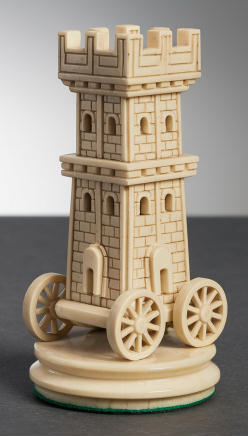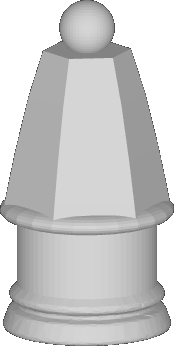Piececlopedia: Dabbabah
Historical notes

This piece was used in some large Shatranj variants, such as Citadel Chess (Shatranj al-husan), Great Chess, Shatranj Kamil, and Tamerlane Chess (Shatranj Kamil or Shatranj Al-Kabir). Its name comes from the arabic دَبَّابَة. In The History of Chess (1860), Duncan Forbes called this piece the Dabbāba or Vineæ
(p. p. 136). In A History of Chess (1913), H. J. R. Murray wrote its name as dabbāba
and describes it as the military instrument called by the Romans Finea, and in the Middle Ages Sow
(A History of Chess, p. 341. On page 11 of The Problemist for July 1926, T. R. Dawson called it a Dabbaba. In Chess Variations (1968), John Gollon wrote it as Dabbabah
and translated it as War Machine
(p. 64). In A Guide to Fairy Chess (1969), Anthony Dickins gave its name as DABBABA
(p. 9). In The Encyclopedia of Chess Variants, David Pritchard said in the entry for the Complete Chess (I), each side had two Dabbabas
(p. 68). Wikipedia calls it a dabbaba and says it was a type of medieval siege engine designed to shelter men who are digging a hole in enemy fortifications (Latin: vinea).
Wiktionary defines the Latin vīnea as (military) a moveable bower used as a shelter.
The Arabic Wikipedia article on دَبَّابَة is on the modern tank, and it says, «مركبة القتال» أما في البلدان العربية فتعرف باسم «الدبابة» أي التي تدب دبا بمعنى تمشي على هينتها والاسم يعود إلى آلة قديمة كانت تتخذ لضرب وهدم الحصون
. As translated to English by Google, this says, In Arab countries it is known as
The Wiktionary page on دَبَّابَة defines it as tank
, meaning that which crawls, meaning that it walks on its own. The name goes back to an ancient machine that was used to attack and demolish fortresses.(historical) A kind of medieval siege engine designed to shelter men who are digging a hole in enemy fortifications
and notes that etymologically, it comes from a word meaning to crawl, to creep
and gives as another definition anything that creeps; an animal that creeps or crawls
. Since Gollon seems to have been one of the main sources for early pages on this site, this and other pages have used his spelling, though spellings without the h are also legitimate, and according to some are the more literal transliteration of the word. Since the h is silent, though, it makes no difference to pronunciation.
In different old chess variants, Dabbabahs were used with different movement rules, e.g., it has been used to name a piece that moved like a normal bishop. The movement given below is the most common and is the one used by modern inventions with the Dabbabah.
Movement
The Dabbabah is a (2,0)-leaper, i.e., it moves two squares horizontally or vertically. It can leap over any piece in its way and will capture any enemy piece on the landing square.
Checkmating
Its severely limited board access makes the Alibaba a very weak piece, but together with a strong minor it might still be able to force checkmate on a bare King. A compound of a Knight and a Wazir (sometimes called Marquis) appears to be sufficient. Try it!
A minor that itself is proficient at delivering mate in all corners does not need to be exceptionally strong when assisted by a Dababba. Try it!
In combination with a color-bound piece on even-sized boards there will always be one corner that neither piece can attack, so that the game will end as a fortress draw if the bare King can reach that corner.
Alternate Images
Click on an image to view the full piece set it belongs to.
 |
 |
Printable Pieces
The following designs are available for printing on a 3D printer. Links are to Thingiverse.
This is an item in the Piececlopedia: an overview of different (fairy) chess pieces.
Written by Hans Bodlaender.
Updated by Greg Strong, H.G.Muller, and Fergus Duniho.
AI image added by Fergus Duniho.
WWW page created: September 04, 1998.
WWW page updated: April 20, 2024.


